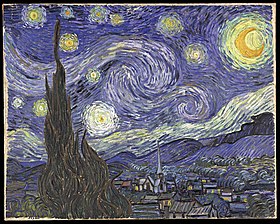
Octave Mirbeau was a French novelist, art critic, travel writer, pamphleteer, journalist and playwright, who achieved celebrity in Europe and great success among the public, whilst still appealing to the literary and artistic avant-garde with highly transgressive novels that explored violence, abuse and psychological detachment. His work has been translated into 30 languages.
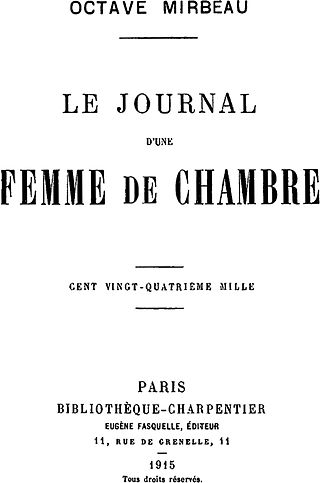
The Diary of a Chambermaid is a 1900 decadent novel by Octave Mirbeau, published during the Dreyfus Affair. First published in serialized form in L’Écho de Paris from 1891 to 1892, Mirbeau’s novel was reworked and polished before appearing in the Dreyfusard journal La Revue Blanche in 1900.

Les XX was a group of twenty Belgian painters, designers and sculptors, formed in 1883 by the Brussels lawyer, publisher, and entrepreneur Octave Maus. For ten years, they held an annual exhibition of their art; each year 20 other international artists were also invited to participate in their exhibition. Painters invited include Camille Pissarro, Claude Monet, Georges Seurat, Paul Gauguin, Paul Cézanne (1890), and Vincent van Gogh.

Business is business is a French comedy in three acts, by the novelist and playwright Octave Mirbeau, performed in April 1903 on the stage of Comédie-Française, in Paris, and worldwide acclaimed, especially in Russia, Germany and United States.
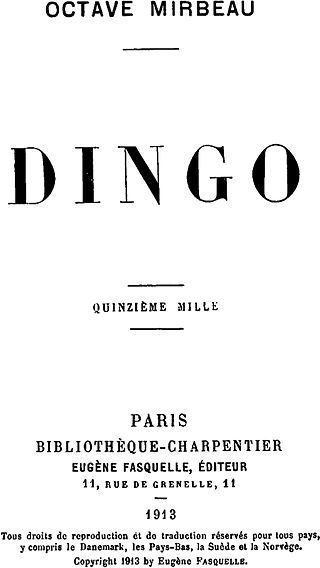
Dingo is a novel by the French novelist and playwright Octave Mirbeau (1913).

La 628-E8 is a novel by the French novelist and playwright Octave Mirbeau, published by Fasquelle in 1907. Part travelogue, part fantasy, part cultural commentary and critique, Mirbeau's book highlights its own unclassifiability: "Is it a diary?”, the narrator wonders. "Is it even the account of a trip?”
Dans le ciel is a novel written by the French journalist, novelist and playwright Octave Mirbeau. First published in serialized installments in L'Écho de Paris between September 1892 and May 1893, Dans le ciel, assembled and edited by Pierre Michel and Jean-François Nivet, first appeared its present form in 1989.
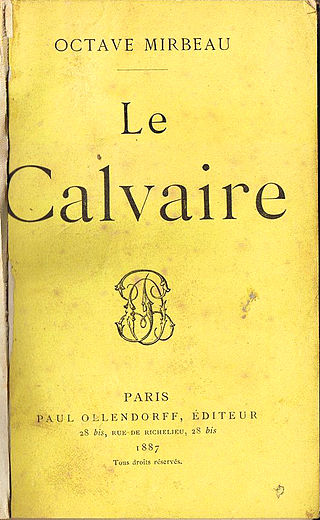
Le Calvaire (Calvary) is a novel written by the French journalist, novelist and playwright Octave Mirbeau, and published by Ollendorff in 1886.
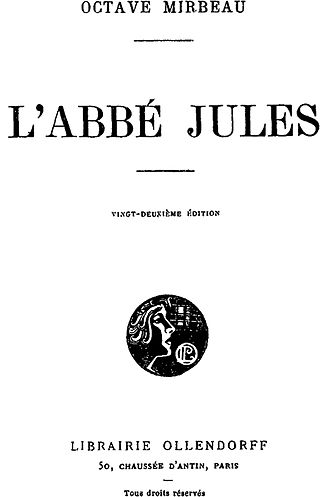
L'Abbé Jules is a novel written by the French journalist, novelist and playwright Octave Mirbeau, and published by Ollendorff in 1888.

Les Vingt et un Jours d'un neurasthénique is an expressionist novel by the French writer Octave Mirbeau, published by Charpentier-Fasquelle in August 1901.
Edmond Couchot was a French digital artist and art theoretician who taught at the University Paris VIII.

Jean Grenier was a French philosopher and writer. He taught for a time in Algiers, where he became a significant influence on the young Albert Camus.

Ismaïla Manga was a Senegalese Jola painter.
Père Pamphile is a fictional character in the novel Abbé Jules, by the French writer Octave Mirbeau (1888). While he is only a marginal figure in Mirbeau's tale, Père Pamphile is nonetheless am extraordinary and striking character, whose history Mirbeau retraces in the course of a long flashback.

Isidore Lechat is a fictional character and the main protagonist of the play Les affaires sont les affaires (1903) by French writer Octave Mirbeau.
Clara is the main character in the French novel The Torture Garden (1899) by Octave Mirbeau.
Contes cruels is a two-volume set of about 150 tales and short stories by the 19th-century French writer Octave Mirbeau, collected and edited by Pierre Michel and Jean-François Nivet and published in two volumes in 1990 by Librairie Séguier. The title was taken from Auguste Villiers de l'Isle-Adam, of whom Mirbeau was a friend and admirer.
Jean Roule is the main fictional character in Octave Mirbeau’s proletarian tragedy, Les Mauvais Bergers (1897). During the first performance, Lucien Guitry played the role of Jean Roule.
Combats littéraires is the title of a 2006 collection of 187 articles and prefaces written by the French writer Octave Mirbeau, between 1876 and 1916, on literature, journalism, and publishing over the course of his long career as an influential journalist. Although Mirbeau collaborated with numerous daily newspapers, he was never officially assigned the work of literary reviewer. Of these articles, some 60 were published between 1925 and 1926 under the title Les Écrivains, and these are available on Wikisource.

Louis de Robert was a French writer, winner of the prix Femina in 1911.
